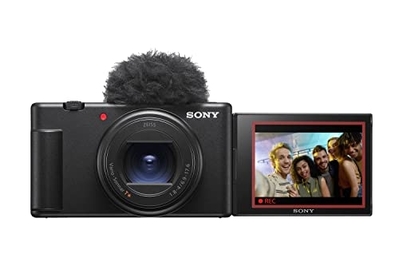Top pick

Compact, light, yet able to record stabilized 4K video, this made-for-vlogging camera represents a great step up for beginners.
When you’ve gotten comfortable with vlogging and are ready to step up your video quality, we recommend the Sony ZV-1 II. It’s designed explicitly to serve as a vlogging camera, with the ability to record 4K video at 30 frames per second and 1080p video up to 120 fps. It also records stereo audio with a clever top-mounted directional mic. The flip-out screen lets you easily frame selfie shots, and the built-in optical image stabilization smooths out your movements.
The ZV-1 II is capable of recording better video than a phone for two main reasons. The first is its 1-inch stacked sensor, which is significantly larger than the image sensors found in most mainstream cell phones. The second reason is that the ZV-1 II pairs the sensor with an f/1.8–4 Zeiss lens, which lets a lot of light fall on the sensor despite its compact size. It also offers a smooth 2.8x zoom, giving you an 18mm-equivalent wide angle and a reasonable 50mm-equivalent telephoto.
This lens isn’t as wide as what you can get from a typical cell phone camera, but at arm’s length you should be able to fit your face and shoulders in the frame, especially if you use any sort of selfie stick or handgrip.

The ZV-1 II’s flip-out screen is easy to use and makes framing selfie footage simple. On the touchscreen, you can choose your focus point, start or stop recording, and access commonly used settings, including the shutter speed and ISO. Beyond the touchscreen, the menu systems and button layout on the ZV-1 II aren’t as intuitive as they could be; vloggers may find that Sony’s phone app (iOS, Android) offers a better way to adjust settings on the fly.
Numerous software features built into the camera make it great for vlogging, as well. For starters, with the touch of a button, you can enable a soft bokeh blur to separate you or your subject from the background. In addition, the fast autofocus can quickly lock in on you, on a separate subject, and then back to you. It can also identify your face and stay focused on you if you move around in the frame.
Although we still recommend a separate mic, the ZV-1 II’s internal mic works quite well and even comes with a furry windscreen “tribble” to keep wind noise at a minimum. A 3.5 mm microphone input and Sony’s MI Shoe mount on top allow you to add an external mic.
The body itself is nicely designed, too, with well-placed grips for you to hold the camera securely multiple ways. Plus, it’s small enough to easily fit in a jacket pocket or purse. On the downside, the screen might be hard to see in bright light, and the camera gives you no way to monitor your audio levels since it lacks a headphone jack.
The ZV-1 II doesn’t have in-body image stabilization (IBIS), but we found that enabling Sony’s software-based Active Steadyshot stabilization on 4K video produced relatively smooth footage. A grip or tripod such as the Joby GorillaPod 1K Kit or Sony’s own Bluetooth controller and tripod can further reduce shakiness. Turning on Active Steadyshot causes the camera to apply a slight crop to recorded clips, but we still fit comfortably within the frame for selfie footage.
Then there’s the matter of price. The ZV-1 II is $900 at this writing. For the features it offers and its overall performance, that is a very good price—in our research, we found many other cameras that offered less for more money. However, $900 is still a lot if you’re unsure whether vlogging is for you.
If you like the sound of the Sony ZV-1 II, but you’d like to save a little money, the original Sony ZV-1, a former pick, remains a great option, and it’s occasionally available for as little as $650 (though its official retail price is $750). It’s similar to the ZV-1 II in size, shape, and capability, but it has a slightly tighter field of view, with a widest focal length of 23mm (in contrast to the ZV-1 II’s 18mm), and its touchscreen is less useful. On the plus side, the ZV-1 has IBIS, so its photos and videos are just a little less shaky than those of the ZV-1 II.

